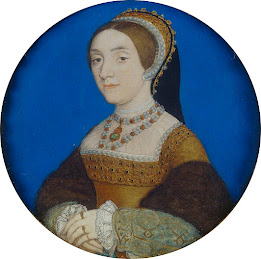1st January - New Years Gifts
The calendar during the Tudor period ran differently to what it is today. To us we see this day as the first day of the New Year, but for Tudors the new year didn't start till 25th March as they were following the Julian calendar (which is today approximately 13 days behind). This changed in 1582 when the Gregorian calender was adopted by Pope Gregory XIII. It had been 8 days since Jesus had been born, it was on this day, that was also known as His Mother's Feast day, he was named and circumcised. Two feasts became popular during the 15th century along with Mass which was in honour of the Virgin Mary. It was seen a special occasion, Royalty wore their best robes and crown then went to Chapel before holding court. They would them reitre to their chambers with special guests for a banquet.

We today give and receive our presents on the 25th December, but for the Tudors they gave presents on New Year's Day. This had started during the Roman Saturnalia and survived until the Tudor age. Those that could afford it were expected to give and recive gifts, those in the lower classes weren't able to take part. Henry VIII and his daughter Elizabeth I used to set out a limit with those in their court on what people had to give them. In 1532 Henry VIII even kept a record of the presents he gave and received from everyone in his court. During the reign of Henry VII and Elizabeth of York, they would receive their personal gifts in their bed chambers and then would give out their gifts in the Great Hall. When Henry VIII took over all gifts were sent and recived in the Presence Chamber in a long ceremony.
Most of Henry's presents were money but given in expensive bags. Another popular gift was goblets and cups, along with shirts knowing that Henry would change his a couple of times a day. In 1532 Lady Anne Boleyn gave the King a spear for hunting boar, which was he favourite past time and in a metaphorical manner of speaking, it was her giving him the tool to "pursue and hunt" her. In 1540 Henry received his most prized treasure, a portrait of his two year old son Edward from Hans Holbein, Henry's court painter.
Gift giving during the Tudor period was a matter of political significance, if the monarch received the gift it was most likely that person was in favour, but if it was rejected it didn't look good. It was also a means of regaining royal favour. Everyone on the royal household received something, in 1511 Henry VIII spent £800 ( £400,000 today) on just gifts alone, which is considerable hit to the finances if we factor in the money spent on feasting!
New Year was also sometimes called Feast of Fools, in Scotland it was known as Unhalieday. This was another day for roles to be reversed and buffoonery to break out. Children were in charge of their parents and the most junior monk was in charge at the Church. During the night more revelry was called for pageants, dancing and music was all expected.
This was also a time for everyone to sit and reflect on the past year and to think of the year that was to come, much like we do today.







Comments
Post a Comment